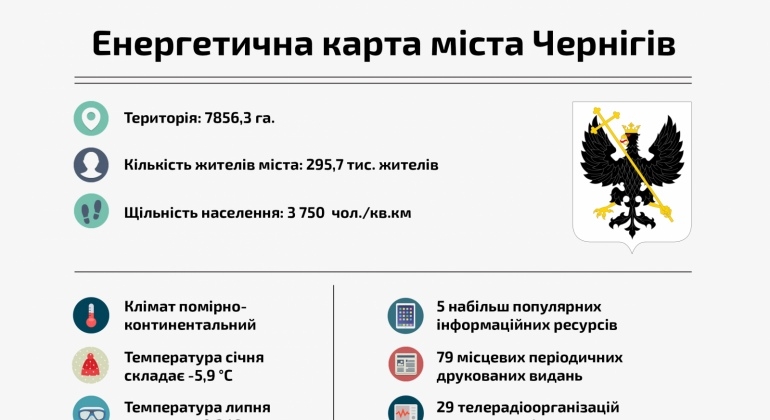Chernihiv Energy Map
Administrative structure of the city
Modern Chernihiv is the administrative, industrial and cultural center of Chernihiv region, which is divided into 2 urban districts: Desnyansky and Novozavodsky.
Geographical location of the city
Chernihiv – a city in the north of Ukraine, in the western part of the Chernihiv region on the tributary of the Dnieper – Desna, occupies the territory of 7856.3 hectares. The city is located at the intersection of Ukraine with Russia and Belarus, at the intersection of transport routes: water, rail, automobile, air. They run from north to south (from Russia, the Baltic States and Scandinavia to Southeastern Europe), from west to east (from Western and Central Europe to Russia).
Demographic characteristics of the city:
– Number of residents of the city: as of January 1, 2014, 295.7 thousand inhabitants live in Chernihiv;
– population density: Chernihiv population density is 3 750 people/sq. KM;
– Gender and age composition: women predominate in the city’s population. At the beginning of 2013, their share was 53.6%, men – 46.4%.
The analysis of the age structure of the city’s residents shows that it is dominated by negative trends. First of all, it is manifested in the reduction of the number of children and adolescents (0-15 years).
The population in working age increased, its share in the total number of inhabitants increased and amounted to 66%. At the beginning of 2013, the largest age group of able-bodied population is 25-30 years. In the future, children and adolescents whose numbers will be much smaller than the populations who will come out of working age will enter the working age. Therefore, the growth of persons older than working age should be expected. The proportion of this age group in the total number of residents of the city increased from 14.9% to 19.7%.
Natural increase
For 2012:
- Born: 10222 (9.4 per 1000 people)
- Dead: 20208 (18.6 per 1000 people)
- Increase: −9986 (-9.2 per 1000 people)
- Chernihiv natural growth for 2012 was -9986 (ie reduced).
- The total coefficient of natural increase (reduction) (per 1000 people of the available population) is –9.2.
Analysis of the climatic conditions of the city
– The climate in the city is moderately continental.
– the average January temperature is -5.9 ° C, for July – +19.2 ° C.
The political situation in the city
The rating of parties presented in the city council
According to a sociological survey of the Polissya Fund of International and Regional Research, support for political parties until January 2014 in Chernihiv was:
Homeland – 17.2%, Party of Regions -14.5%, CPU -7.5%, BRACK – 4.4%, strong Ukraine – 2.6%, civic position -2.2%, radical party – 1.9%, freedom – 1.8%. But given the events that took place in Ukraine in February 2014, the Party of Regions completely lost its supporters in Chernihiv.
Analysis of the Party of Heads of Executive Bodies in the City
During February – early March 2014, the vertical in the Chernihiv region underwent significant formatting. Head of the regional state administration, a member of the Party of Regions, Vladimir Khomenko, who held this position since 2007. The new head of the Chernihiv Regional State Administration was appointed a deputy of the regional council on Vladimir Ivashko’s Batkivshchyna faction.
After the tragic events of the Euromaidan and the self -removal of the President from the leadership of the country, the majority of heads of district state administrations, district councils and city councils of regional importance of Chernihiv region left the ranks of the Party of Regions. As of March 14, 2014, in the Chernihiv region, from 22 heads of district state administrations, 18 considered themselves non-partisan, the rest of the posts remained vacant or the head of the RDA wrote statements for dismissal at their own request. Chernihiv Mayor Alexander Sokolov is non -partisan. The secretary of the city council in Chernihiv elected the head of the Batkivshchyna Batkivshchyna faction.
Deputies of the Verkhovna Rada of Ukraine related to the city
Valeriy Drinity – Batkivshchyna Party, Mykola Nikolaevich Rudkovsky – non -fractional, Vladislav Anatoliyovych atroshenko -non -factional, Ivan Ivanovich Kurovsky – non -factional.
City Media Market
In Chernihiv region there is:
18 TV and radio organizations (state-2, communal -3, private -3), broadcast 29 TV and radio organizations of national broadcasting;
The 79 local periodicals (69 newspapers, 8 magazines, 2 collections with a total single circulation of 830 thousand copies) are released regularly. The stamp editions are the most pre -efficient – “Desnyanskaya Pravda”, “Hart”.
A number of information resources are presented on the Internet – the most popular are “High Shaft”, “Events and Comments”, “Siverschyna”, “Chernihiv Monitor”, “Gorod.cn.ua”.
Characteristics of the city’s energy sphere
Centralized heat supply and hot water supply
The largest suppliers of thermal energy and hot water supply services (DHW) to the population, budget and municipal enterprises are PJSC “Regionteplocomunenergo” – 54% and KAP “Chernihiv TPP” of Firma LLC “Technova” – 46%.
Thermal power of the CHP is 409 Gcal/h, electric -210 MW. On the balance sheet of the enterprise: 63CP (central thermal points); 113 km of water thermal networks. According to the company, the connected thermal load is:
– for heating – 181.17 Gcal/h,
– for hot water (max.) – 51.96 Gcal/h.
For the production of thermal and electricity it uses natural gas and coal brands of AS with heat of combustion of 5189 kcal/kg.
The enterprise of PJSC “Oblastteplocomunenergo” includes 39 boiler rooms; 49 CTP. Total capacity of 253.7 Gcal/h. Natural gas is used as fuel.
Gas supply
PJSC “Chernihivgas” is a gas transport operational complex, which consists of 9 departments and 11 areas for gas supply and gasification, Minsk GNS, Pryluky GNS, AGNNS Chernihiv and the main enterprise. The enterprise provides the following areas of activity:
– transportation of natural gas;
– sale of liquefied gas;
– execution of design works and work on gasification;
– maintenance and repair of gas equipment.
The length of distribution gas pipelines and inputs in the Chernihiv region is almost 13222 km.
Power supply and outdoor lighting
The electricity of consumers of the city of Chernihiv is provided by the separate unit “Chernihiv city electrical networks” of PJSC “Chernihivoblenergo”. Electricity supply is made from 4 substations 110/35/10kv, 2 substations 35/10 kV, 145 feeders of 10 kV, the length of cable transmission lines of all pcs/km 3076/939,3 km voltage 10kV, pcs/737/499,9,9,9 The length of the air lines is -346 km with a voltage of 10kV-33.2kV, 0,4kV-312,8km. Technological losses of electricity on its transportation amounted to 9.94% at the rate of 9.97%. The length of air networks of the city outdoor lighting system is 532.28 km, cable lines – 48.84 km, the number of electricity metering devices – 152 units. The outdoor lighting networks are on the balance sheet of the city council of housing and communal services. The service of external lighting networks is performed by the Municipal Enterprise “Regional World” Chernihiv Regional Council.
The total number of lanterns involved in the city’s external lighting system is 15686 units, including:
– with incandescent lamps -4041od.,
– with mercury lamps DRL-3397 units,
– with sodium lamps DNAT-8248 units
Water supply and drainage
It is carried out by the municipal enterprise “Chernihivvodokanal”. The source of water supply of the city is groundwater. The total number of wells 97pcs, of which 13 came out. The quality of the water supplied to the water supply network fully meets the requirements of GOST 2874-82 “Drinking Water”.
The drainage system consists of self -flowing collectors, sewage treatment plants (Kos). The centralized sewage system covered 57% of the total area of the city -4501 ha.
Transport complex
Chernihiv transport includes:
City trolleybuses: 67 trolleybuses are obtained on routes daily;
Bus – Bus transportation on a contractual basis is carried out by 14 carriers;
Railway: includes railway transport corridor №9 / Helsinka-Petersburg-Minsk (Moscow) -Kyev-Kishin (Odesa)-Dmitry-Dmitry / passing through the Kiev-Nizhin-Chernihiv-Gornostaivka. Ovruch-Chernihiv, Chernihiv-Gomel;
Highway system-the highway highway of national importance of Kyiv-Chernihiv-Novi Yarylovichi (with a detour road in Chernihiv) coincides with the International Road of the E-95 St. Petersburg-Petersburg-Pskov-Homel-Odesa and is at the same time a section of the Criton Roytiv Automobile Transport Corridor №9;
River transport: represented by the port enterprise of OJSC “Chernihiv River Port”, on the River Desni.
The industry and construction industry of the city
Chernihiv is a city with developed industry and construction infrastructure. The city’s industry is represented by 384 business entities. Among them are the 16 largest industries in the city – food, light, machine -building, electricity, gas, vapor and air conditioning. There are 67 construction enterprises and organizations in the city.
Basic CO2 emissions in town
The volume of CO2 emissions in 2008 was 5.93 tons/year per residents and during 2009 – 2010 it was slightly declined and amounted to 5.77 and 5.89 tons/year per resident, respectively.
Potential to reduce CO2 emissions in city
Based on the existing dynamics of greenhouse gas emissions, which is given in the table, the program of sustainable energy development of the city of Chernihiv to 2022 proposes the implementation of energy -saving measures in the segment of transport, population, heat supply enterprises, and budgetary institutions. In order to fulfill the planned reduction of carbon dioxide by 2022, which provides for the program (reduction of 16.4 %), it is necessary to obtain a duty reduction of 0.97 tons/ C2 emissions in a natural amount. The implementation of the Program provides for the involvement of state financial support to update the rolling stock of trolleybuses, construction and reconstruction of trolleybus lines; implementation of energy saving measures through the use of the latest technologies, structures and special parts for contact networks and traction substations; Increasing the volume of transportation by city electric transport due to changes in the schemes of movement of city passenger transport transport and organization of new routes.


